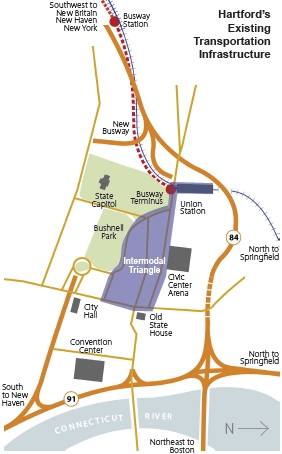
Over the next four years, Connecticut will welcome two new transit systems, the CTfastrak bus rapid transit system connecting New Britain and Hartford (set to open in 2014), and the New Haven-Hartford-Springfield commuter rail line (set to open in 2016). The new lines will run through many areas that currently lack public transit other than local buses. For both systems to succeed, it will be critical that the areas around stations are oriented around transit — with zoning for mixed-use development and quality pedestrian and bicycle routes that connect the stations and surrounding neighborhoods.
The City of Hartford’s efforts, which benefited from a federal TIGER grant awarded last month, offer a good model. The grant will fund complete street improvements, including bus lanes, bike lanes, and pedestrian safety improvements on streets near Hartford’s Union Station, where both new services will stop. The city will also realign local bus routes to improve transfers and expand pedestrian wayfinding. The grant application notes that city, regional, and state leaders “are committed to bringing as many as 4,000 additional [housing] units downtown with an emphasis on transit orientation.”
This integration of different transportation modes is needed at every station. But ConnDOT can’t count on new federal funds. The just-passed federal bill, MAP-21, does include a grant program for transit-oriented development (TOD) planning around new projects like CTfastrak. But it also slashes federal funds for pedestrian and cycling improvements. Instead, ConnDOT must work with towns to identify needed pedestrian and cycling improvements. It could also look to its neighbors: New Jersey and New York City have “Safe Routes to Transit” programs that fund safety improvements near transit stations.
Writing that “Connecticut has a once-in-a-lifetime chance,” Hartford Courant editor Tom Condon used his column last month to call on the state to take a larger role in TOD:
Planning TOD requires a certain sophistication; it means getting a mix of residential, commercial, retail and parking to work together, along with bike and pedestrian access and, hopefully, some public space. Assembling the land and preparing the development agreements, not to mention finding the money, also involve a level of complexity that is beyond the ken of most of towns. In short, if we are to have TOD, the state is going to have to step in and help.
There are people in state government who get this. Kip Bergstrom, deputy commissioner of the Department of Economic and Community Development, said officials are in discussion about the kind of entity — possibly a public-private partnership — needed to made TOD happen. When Bergstrom worked in Stamford he estimated that there were nearly 1,000 acres of developable land near the train stations in Norwalk, Stamford, Bridgeport and New Haven. Add the empty land around Union Station in Hartford, and these areas could absorb a lot of the state’s growth, and create livelier cities in the process.
Connecticut has taken some important steps already. Last year, the state awarded TOD grants to several municipalities on the new lines as part of a pilot program. But it’s time to move past the pilot stage. What is needed now is a formal program or multi-agency team that can assist municipalities interested in TOD.
Municipalities (such as New Britain and Newington) have already begun to attract and plan for development around the new transit systems. By getting more proactive on TOD and pedestrian and bicycle connections, ConnDOT can maximize the investment it is making in new transit.

[…] Tri-State has argued before, Connecticut’s state agencies must be more proactive about supporting opportunities […]
THIS IS FINALLY ONE OF THE BEST COLUMNS ABOUT THE UPCOMING CTFASTRAK PROJECT AND HOW IT CONNECTS WITH THE REST OF THE STATE. it’s great that this bus roadway will connect with rail. little do most people realize at this point in time, but the central connecticut area will be booming in the coming years as transit options grow and grow.
[…] Transit funding and TIGER – MAP-21, despite its flaws, avoids cuts to transit and actually increases federal transit funding in New York, New Jersey and Connecticut. The tri-state area also benefited from TIGER grants that will fund projects in Rochester, the Bronx, northern New Jersey and Hartford. […]
[…] by developing a complete streets and bicycle connectivity plan. Elsewhere in Hartford, the iQuilt project will marry local bus, pedestrian safety and bike improvements. Local governments are leading […]
[…] system. Both will expand access to jobs in Hartford and the surrounding region. The city is also reconfiguring downtown streets and bus lines to improve transportation connections and make the area more […]